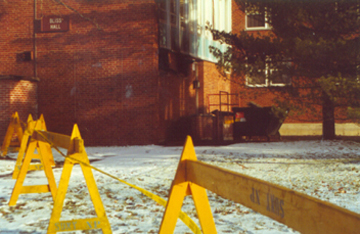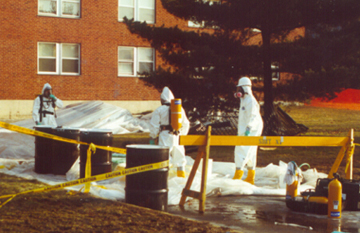


�� ���On Monday morning, Dec. 30,� 1992, I set out on the three-block walk from the Student Leader� News Service office in New Paltz with city editor Ian McGowan,� headed for the college's first official news conference after� the prior day's PCB explosions on the campus. Ian and I had visited� a lot of strangeness together in the course of our reporting,� but what we would soon discover on the New Paltz campus was beyond� compare. As we approached Bliss Hall, above, we saw the first� sign that something was wrong. We had been following events from� our office for the past 24 hours. Two hundred emergency personnel,� from state police to the Red Cross to the hazardous materials� teams from IBM in Fishkill had responded to the prior day's electrical� fires and explosions. About 25 people were taken to area hospitals� for contamination.
� �

�� ���A Westinghouse electrical transformer� containing 100 gallons of polychlorinated biphenyl (PCB) insultation� fluid had malfunctioned after a car accident two miles from the� campus damaged power lines. Electrical arcing -- a major malfunction� consisting of a lightning bolt of current running through the� "fireproof" fluid -- had caused the creation of highly� flammable phosgene gas within the airtight container, and exploded� with sufficient force to blow out the louvres and blow off the� back door of the dormitory. We did not know it at the time but� the toxins levels inside the Bliss transformer room were later� rated at one million times the state's acceptable limit for PCB� contamination. Of course dioxins were also created in the building� and found as high as the third floor. Smoke surging through the� building contaminated heat and ventilation systems. The miracle� is that because this happened right before New Year's eve, there� were no students in the all-women's dormitory at the time. Any� students on camous staying through the holidays had been housed� in Capen Hall across the quadrangle, where what seems to have� been the least severe fire occurred. About a dozen students in� Capen were evaculated through a thick haze of sickly sweet-smelling� PCB and dioxin-laced smoke, which moved throughout the building.
� �

�� ���When I returned to Bliss Hall� a week later, this is what I saw. Needless to say, this is a� strange sight in your own neighborhood. The workers are wearing� what is called level B protection. You can tell because they� are wearing air tanks. With the only higher level, level A, the� air tanks are concealed inside the Tyvek suits; level C consists� of Tyvek and HEPA filters like the man on the right, apparently� a supervisor, is wearing. It is rare for haz-mat workers to wear� level B out-of-doors where there is a natural supply of fresh� air, particularly in cold weather (where they do not need the� cooer air provided by the tanks). Toxins levels must be extremely� high to require level B outside. The tree in the background and� another, not in the photo, to the left, were taken to a toxic� waste landfill, along with student property in half the building� (the rest of the student property was returned without cleaning).� Heaters were eventually cleaned and the vents were changed, though� toxins remained in the building when it was opened to students� just one year later. Excavation beneath the building went down� about 10 feet and toxins began to spread through the ground water� in the Earth far below. But we're ahead of ourselves here --� the next page's photos continue with what we witnessed Dec. 30,� 1992, the day after the fires and explosions.